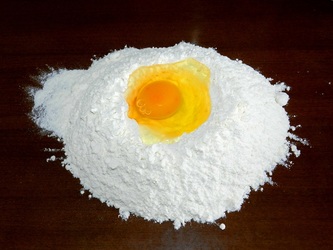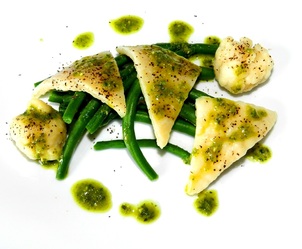
Looks simple? Not really!
One of my the shows that I'm watching that really triggers me to expand my cooking repertoire is Masterchef Australia. The show is unbelievably entertaining (Mehigan and Calombaris make for some nice characters in the kitchen) and the idea of amateur cooks (a bit like myself) just putting themselves out there to build a career in food is just great.
In such shows, it seems like that people are expected (unreasonably, in my opinion) to be able to make past from scratch even if, in reality, most Italian restaurants (including those here in Italy as well) use dry pasta. I mean, okay, if you want to make custom-made ravioli or tortellini where you can put your own stuffing (like crazy ones like fish or egg yolk), clearly you have to roll out your own pasta but for other things ranging from lasagna to fettucini, the store-bought dry variety should be sufficient (especially if you live in Italy anyway since even the cheapest of packaged pasta is still of high quality).
In fact, not that I have seen a lot of other italians cook, but I've never heard of people making their own pasta (save for maybe grandmothers cooking for a special Sunday lunch) though it could also be regional (I've had a friend say that her friend from the Emilia-Romagna region [held to be the most foodie of all the regions] rolls out her own pasta every now and then, as her grandma taught her). That being said, I can't really go away from Italy never having tried to do this (if I'm gonna try to do this right, why not while I'm in Italy... maybe the air or the spirit will help me) so I decided to give it a go - I was hoping that the skill will come in useful for making my own gourmet ravioli or for making gnocchi from things other than potato.
In such shows, it seems like that people are expected (unreasonably, in my opinion) to be able to make past from scratch even if, in reality, most Italian restaurants (including those here in Italy as well) use dry pasta. I mean, okay, if you want to make custom-made ravioli or tortellini where you can put your own stuffing (like crazy ones like fish or egg yolk), clearly you have to roll out your own pasta but for other things ranging from lasagna to fettucini, the store-bought dry variety should be sufficient (especially if you live in Italy anyway since even the cheapest of packaged pasta is still of high quality).
In fact, not that I have seen a lot of other italians cook, but I've never heard of people making their own pasta (save for maybe grandmothers cooking for a special Sunday lunch) though it could also be regional (I've had a friend say that her friend from the Emilia-Romagna region [held to be the most foodie of all the regions] rolls out her own pasta every now and then, as her grandma taught her). That being said, I can't really go away from Italy never having tried to do this (if I'm gonna try to do this right, why not while I'm in Italy... maybe the air or the spirit will help me) so I decided to give it a go - I was hoping that the skill will come in useful for making my own gourmet ravioli or for making gnocchi from things other than potato.

Pasta? Not really... I ended up with Slavic flour dumplings!
Recipes on the internet and on Masterchef seem to agree that for 100-125g of flour (type "00"), one needs one egg... However, being that I had no measuring implements (another cause for error), I could only guess-timate.
Procedure goes - make a mound of flour on your work surface, make a well, crack the egg into the well, mix lightly at first (incorporating a bit of flour) before trying to mix it thoroughly. Once all is incorporated, knead the dough - work it until the "gluten develops" (I'm a soft matter scientist and as food is usually "soft matter" I want to get to the bottom of things but I have yet to understand what this phrase really means molecularly). As they say, there is no secret to kneading, you just have to bash the mixture on your surface to work it, gather it up together and repeat.
One thing the internet can't capture though is the actual experience of making pasta - the touch and feel of a "correct" dough and the hand technique (maybe there is) one must use in kneading so those are the stuff I tried to figure out along the way (didn't work). I did learn that kneading is hard (and questioned why I ever attempted to do this... I get the same feeling when cleaning mussels) and that one should wait and not add things too much, too soon (thinking that my pasta had too much flour, I added some olive oil which resulted in the dough becoming slightly oily).
My end result lacked the "elasticity" or springiness that one sees in pastas rolled out professionally in tv and was more crumby, probably from too much flour and ended up being something probably closer to a shortcrust pastry - the one you use for making tarts and pie crusts! As I wasn't in the mood for dessert though, I did decide to just salvage my result and make flour dumplings (inspired by my recent trips to Eastern Europe!).
As dumplings, my flour mixture was still too floury so after cooking the pieces in boiling water, the center usually still remains crumby (which is not so bad in dumplings) and I did enjoy it as the starch-form of my meal. At the end of the day, lesson is that I could try making pasta some other time knowing that I could make dumplings with what comes out anyway!
Procedure goes - make a mound of flour on your work surface, make a well, crack the egg into the well, mix lightly at first (incorporating a bit of flour) before trying to mix it thoroughly. Once all is incorporated, knead the dough - work it until the "gluten develops" (I'm a soft matter scientist and as food is usually "soft matter" I want to get to the bottom of things but I have yet to understand what this phrase really means molecularly). As they say, there is no secret to kneading, you just have to bash the mixture on your surface to work it, gather it up together and repeat.
One thing the internet can't capture though is the actual experience of making pasta - the touch and feel of a "correct" dough and the hand technique (maybe there is) one must use in kneading so those are the stuff I tried to figure out along the way (didn't work). I did learn that kneading is hard (and questioned why I ever attempted to do this... I get the same feeling when cleaning mussels) and that one should wait and not add things too much, too soon (thinking that my pasta had too much flour, I added some olive oil which resulted in the dough becoming slightly oily).
My end result lacked the "elasticity" or springiness that one sees in pastas rolled out professionally in tv and was more crumby, probably from too much flour and ended up being something probably closer to a shortcrust pastry - the one you use for making tarts and pie crusts! As I wasn't in the mood for dessert though, I did decide to just salvage my result and make flour dumplings (inspired by my recent trips to Eastern Europe!).
As dumplings, my flour mixture was still too floury so after cooking the pieces in boiling water, the center usually still remains crumby (which is not so bad in dumplings) and I did enjoy it as the starch-form of my meal. At the end of the day, lesson is that I could try making pasta some other time knowing that I could make dumplings with what comes out anyway!
 RSS Feed
RSS Feed